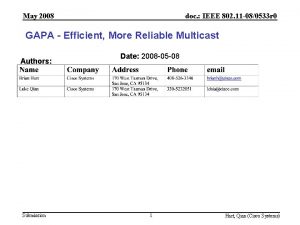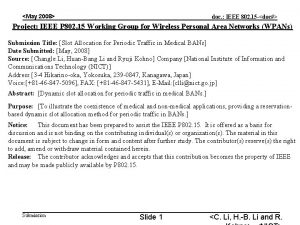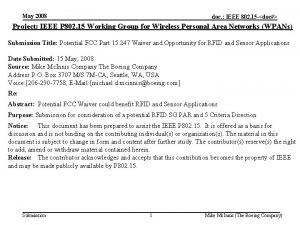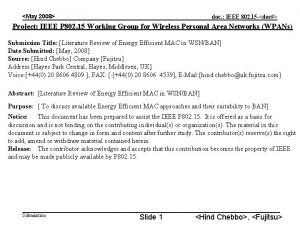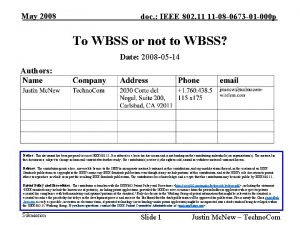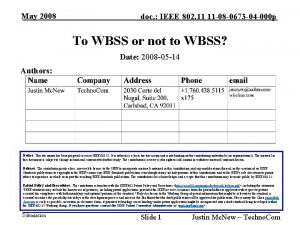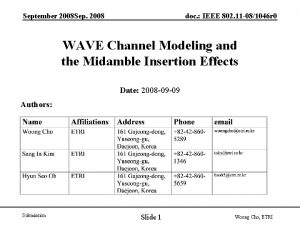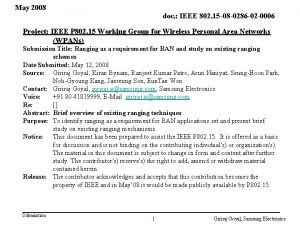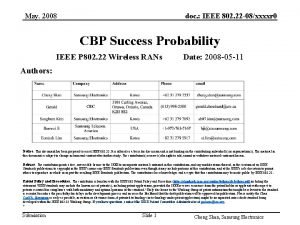May 2008 doc IEEE 802 11 080533 r













- Slides: 13

May 2008 doc. : IEEE 802. 11 -08/0533 r 1 GAPA - Efficient, More Reliable Multicast Authors: Submission Date: 2008 -05 -08 1 Hart, Qian (Cisco Systems)

May 2008 doc. : IEEE 802. 11 -08/0533 r 1 Requirements for Multicast Video Requirements • Very low PLR • Low delay and delay jitter • Multiple transmissions per beacon period • Compatible with legacy STAs • Duplicate detection Objectives • Efficiency (since video throughput can be high) • Feedback for rate adaptation • Compatible with power save Submission 2 Hart, Qian (Cisco Systems)

May 2008 doc. : IEEE 802. 11 -08/0533 r 1 Few candidate solutions meet these requirements • (1) Existing multicast − No retries, no Acks, no inputs to rate adaptation, sent infrequently Doesn’t work without retries (3 retries assumed) Submission 3 Hart, Qian (Cisco Systems)

May 2008 doc. : IEEE 802. 11 -08/0533 r 1 Few candidate solutions meet these requirements • Retransmitting multicast frames a fixed number of times − Inefficient if all receivers receive the frame correctly the first time − No feedback for rate adaptation − Legacy STAs cannot be guaranteed to perform duplicate detection and discarding correctly • (2) Multicast-to-unicast conversion − Increases delay for later receivers − Increases delay jitter for later receivers − Multiplies the number of packets over the air for an already highthroughput application − Can’t be used with bridges if MC-ness not preserved • Retransmitting multicast frames with a delayed Block Ack policy − Block Acks must contend for the medium Submission 4 Hart, Qian (Cisco Systems)

May 2008 doc. : IEEE 802. 11 -08/0533 r 1 Proposed Solution “Group-Addressed PSMP Ack” (GAPA) is More Efficient and More Reliable • (3) Transmit multicast frames via PSMP • PSMP bursts comprise: − PSMP sequences, which in turn comprise: – Downlink phase – for MC data – Uplink phase – for PSMP Acks to MC data − The first PSMP sequence – Sends the MC data in the DTT – Retrieves scheduled ACKs in the UTT − Subsequent PSMP sequences are used for MC data retries if needed − All within the same TXOP • Scheduled PSMP may make sense for some applications The benefits of GAPA are orthogonal to using scheduling to avoid collisions. Likely both problems need to be solved via complementary proposals Submission 5 Hart, Qian (Cisco Systems)

May 2008 doc. : IEEE 802. 11 -08/0533 r 1 Three Main Schemes Illustrated Data (1) MC (2) MC 2 UC Data ACK 2 ACK 1 Data ACK 3 (3) GAPA Data ACK 1 ACK 2 ACK 3 Delay Submission 6 Hart, Qian (Cisco Systems)

May 2008 doc. : IEEE 802. 11 -08/0533 r 1 Anticipated Characteristics of the Three Schemes Multicast Unicast PSMP Data frames repeated No (>=1) x #dest 1+#retries ACK No Yes Packet Loss Rate Too high to meet requirement Low Delay and delay jitter Low Too high Low Capacity High Low Medium Rate The lowest in the MC group Individual rate for each The lowest of the un. Acked members of the MC group Complexity Low High Submission 7 Hart, Qian (Cisco Systems)

May 2008 doc. : IEEE 802. 11 -08/0533 r 1 Preliminary Simulations N x [3 video devices at [24, 54, 130] Mbps in a single BSS with a fixed PER] ms) Low throughput video (max 360 kbps) For a delay limit of 20 ms, GAPA allows for a 7 times increase in capacity over MC 2 UC! (Courtesy of Luke Qian) Submission 8 Hart, Qian (Cisco Systems)

May 2008 doc. : IEEE 802. 11 -08/0533 r 1 GAPA is compatible with legacy (= pre-11 aa) • Since we cannot depend upon legacy’s ability to perform duplicate detection with MC (see 9. 2. 9), then retries need to be hidden from legacy • GAPA is hidden from legacy by sending GAPA transmissions to a different MC MAC address − GAPA-capable STAs request GAPA for selected MC TSPECs − The accepted TSPEC response includes an alternative, AP-allocated, otherwise-unused MC address (called GAPA MC MAC address) − If legacy TSPECs are part of the MC group, frames are (also) sent via legacy MC & addressed to the normal MC address – Ignored by STAs with GAPA TSPECs − If GAPA TSPECs are part of the MC group, frames are (also) sent via GAPA & addressed to that MC group’s GAPA MC MAC address − GAPA BC is sent to a special MAC address (TBD – e. g. ff-ff-ff-fe) − BA agreement (rather than TSPEC) may be sufficient • GAPA MC duplicate detection is provided by: − Same sequence number for all retries Submission 9 Hart, Qian (Cisco Systems)

May 2008 doc. : IEEE 802. 11 -08/0533 r 1 GAPA can be robust to lost STAs • If retries are exhausted for a specific STA say a threshold number of PSMP bursts in a row, possibly that STA has roamed away without disassociating / been turned off / etc. − Call this a lost STA • The AP may disassociate the lost STA, or decline that lost STA’s TSPEC, or no longer send retries if only lost STAs have not Acked the MC data Submission 10 Hart, Qian (Cisco Systems)

May 2008 doc. : IEEE 802. 11 -08/0533 r 1 Summary of GAPA Benefits • All STAs receive the data simultaneously − Reduced delay and delay jitter • Data is sent once and only retried when necessary − Better capacity • Acks are scheduled as efficiently as possible − Better capacity, reliability, and enables rate adaptation • Compatible with power saving mechanisms • Compatible with legacy MC/BC • GAPA provides for duplicate detection • GAPA is complementary to collision-avoidance scheduling mechanisms Submission 11 Hart, Qian (Cisco Systems)

May 2008 doc. : IEEE 802. 11 -08/0533 r 1 Questions ? Submission 12 Hart, Qian (Cisco Systems)

May 2008 doc. : IEEE 802. 11 -08/0533 r 1 Strawpoll • Would you support the GAPA scheme in 11 aa? Submission 13 Hart, Qian (Cisco Systems)














